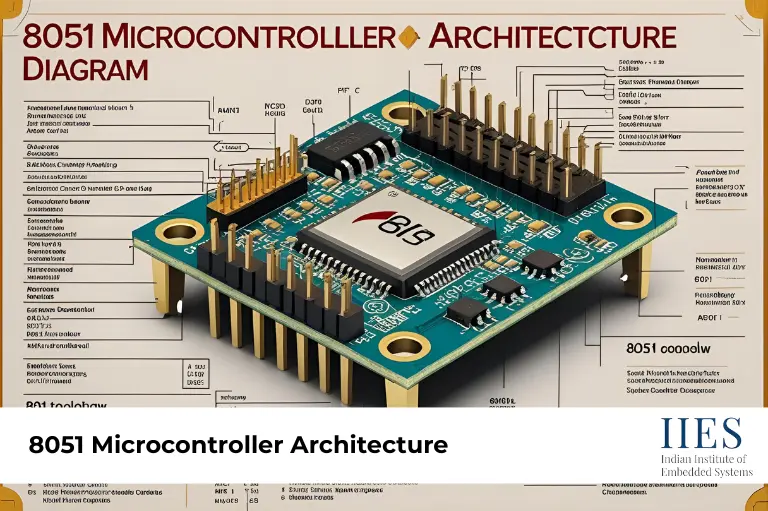
Microcontrollers power the devices we rely on daily, from smart appliances to industrial machines. Among them, the 8051 Microcontroller Architecture stands out as one of the most influential. This guide takes you through its architecture, functions, and why it still matters in today’s embedded systems world.
The 8051 microcontroller is a widely used, beginner-friendly chip that forms the backbone of embedded systems. Known for its simple 8051 architecture diagram, versatility, and reliability, it remains a popular choice for learning and real-world applications.
Microcontrollers were designed to provide compact and efficient control for electronics. In 1980, Intel introduced the 8051 microcontroller pin diagram, and it quickly became a game-changer. Its balance of simplicity and flexibility made it ideal for both learning and professional use.
Even with advanced microcontrollers available today, the 8051 remains relevant. Its clear architecture, huge support base, and diverse applications of 8051 microcontroller ensure it continues to be taught in classrooms and deployed in industries.
Microcontrollers often get confused with microprocessors, but they serve different purposes. While a microprocessor needs external components like memory and input/output circuits, a microcontroller like the 8051 has everything built in.
From washing machines to IoT sensors, embedded systems depend on microcontrollers. Their ability to perform dedicated tasks efficiently makes them the “brains” behind modern electronics.
The 8051 microcontroller is an 8-bit processor with a Harvard architecture. It comes with built-in memory, I/O ports, and timers, making it self-sufficient for most applications. Its 8051 microcontroller memory organization ensures efficient data handling, even with limited resources.
These features of 8051 microcontroller highlight why it remains a learning standard.
The 8051 is made up of several building blocks that allow it to execute programs and interact with the outside world.
These ports let the 8051 communicate with external devices like sensors, motors, and displays.
Provide accurate timing and event counting, essential for automation and time-critical tasks.
Enables the 8051 to transfer data with other devices, vital for IoT and networking applications.
8051 microcontroller interrupts allow the microcontroller to pause its current task and respond quickly to urgent events.
Keeps the microcontroller running in sync by generating clock signals.

Instruction Set of the 8051
The 8051 microcontroller instruction set defines how the chip processes data:
Efficient memory design ensures smooth performance:
This 8051 microcontroller memory organization ensures scalability and reliability.
Learning to program the 8051 microcontroller programming is an excellent entry point for beginners in embedded systems. The process involves:
Hands-on practice is key—starting with LED blinking and moving toward complex applications like motor control or sensor interfacing.
The applications of 8051 microcontroller is not just a learning tool—it powers many practical systems:
Consumer electronics like washing machines and microwave ovens
Industrial automation and robotics
Communication systems and IoT devices
Medical instruments and security systems
Its adaptability and low cost make it a favorite in both commercial products and research projects.
Like any technology, the 8051 comes with challenges:
Limited memory compared to modern microcontrollers
Lower processing speed
Dependency on assembly language for complex tasks
Still, these challenges are opportunities for learners to strengthen their problem-solving skills.
While newer microcontrollers like ARM Cortex dominate modern designs, the 8051 microcontroller advantages and disadvantages continues to play a strong role in education and small-scale applications. With IoT and smart devices on the rise, its simplicity makes it an excellent choice for prototyping and learning.

The 8051 microcontroller is more than just a historic chip—it’s a gateway into embedded systems. Its 8051 microcontroller architecture diagram, instruction set, and real-world applications make it invaluable for students and professionals alike. By mastering the 8051, learners build a solid foundation for advancing into modern microcontroller families.
The 8051 is an 8-bit microcontroller introduced by Intel with built-in memory, I/O ports, timers, and interrupts that define its architecture.
It is used because of its simplicity, reliability, and wide availability, making it ideal for both education and practical embedded applications.
Yes, it is still widely used in education and in cost-effective embedded applications.
It has four 8-bit ports, totaling 32 I/O pins.
The 8051 supports five interrupts, including two external, two timer, and one serial interrupt.
It uses Harvard architecture with separate memory for instructions and data.
Indian Institute of Embedded Systems – IIES